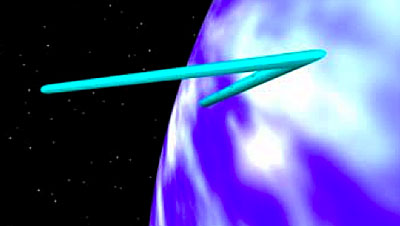Floating to spaceJP Aerospace unveils a unique way of getting into orbitby Jeff Foust
|
| “People have never figured out JP Aerospace,” Powell said. |
However, Powell said, all of these projects are part of a single, coherent plan that JP Aerospace has been following since the beginning. That plan is an effort to devise a better way to get into space than chemical rockets. Powell unveiled that plan at Space Access with a simple, descriptive title: Airship To Orbit.
Three-part architecture
As the name suggests, Airship To Orbit (ATO) involves flying lighter-than-air vehicles from the surface into low Earth orbit without the need for rockets of any kind. A single airship would be unable to fly from the surface to orbit: conventional airships are too heavy, while those large and light enough to make the trip would not survive the winds in the lower atmosphere. Instead, JP Aerospace has devised a three-step architecture to carry payloads of up to several tons into space using airships.
The first step is an atmospheric airship, the Near Space Maneuver Vehicle (NSMV), also called the Ascender, designed to fly from the surface to the upper atmosphere. The V-shaped airship would use a combination of buoyancy and aerodynamic lift to fly, powered by propellers specially designed to operate in the upper atmosphere. The airship would have a crew of three and carry an unspecified mass of cargo or passengers.
The second step in the architecture is the Dark Sky Station, in essence a waystation in the upper atmosphere. The balloon-supported facility, over three kilometers across, would hover at an altitude of over 42 kilometers (140,000 feet) in the polar vortex, circling over the Arctic Circle. The Dark Sky Station would serve as the destination for the Ascender airships, as well as the assembly point for the final step in the architecture.
That final step would be another airship that is much larger than the Ascender. The Transatmospheric Ascender would be a giant airship, nearly two kilometers across, too large and light to survive in the lower atmosphere. The airship would use its buoyancy to drift up from the station to about 60 kilometers altitude, at which point it would use an electric propulsion system to gradually reach orbital velocity and altitude over a five-day period. Powell said they are looking at three different propulsion systems for the airship: a conventional ion propulsion system and two confidential designs.
Real hardware, ambitious schedule
It would be easy to dismiss ATO as simply an interesting idea—or worse—but for the fact that some elements of the system are already being built. Under an Air Force contract JP Aerospace has been developing the NSMV, developing several subscale vehicles as well as a full-sized one, over 50 meters long. The full-scale NSMV is currently in a hangar in Texas, with flight tests slated to begin later this month. The Air Force is not necessarily interested in the ATO concept—they see the NSMV as a potential high-altitude reconnaissance platform—but their support has paved the way for continued development of the system.
Besides the low-altitude airship, JP Aerospace has continued work on the Dark Sky Station. Several subscale models of the station have been carried aloft to up to 30 kilometers high, allowing JP to test every component of the system at that altitude. JP also plans to carry an ion engine to 35 kilometers altitude later this year as an initial test of the propulsion system for the orbital airship.
| “We’re not looking for that big cash infusion,” Powell said. “Real customers have written real checks.” |
While ATO has been under development for over two decades, the project now has an ambitious schedule. The initial NSMV flight tests are planned for this month, and the first manned flights of the Dark Sky Station are planned for about 18 months from now. Powell said that the plan calls for completing the entire architecture in about seven years. “We’re actually just a hair ahead of the game,” he said.
Despite their bold plans and schedule, JP Aerospace is not seeking funding. Powell said that they have adopted a “pay as you go” philosophy for its development, with each element of the architecture serving as a profit center. Besides the Air Force’s use of the NSMV as a reconnaissance system, the Dark Sky Station has generated interest among telecommunications companies. “We’re not looking for that big cash infusion,” Powell said. “Real customers have written real checks.”
Crazy enough to work?
The reaction to the ATO concept among Space Access attendees was a mix of interest and skepticism. The concept of a system that could be potentially far cheaper and more robust than conventional rockets was certainly attractive to the audience. However, some raised concerns about various aspects of its implementation. For example, the radiation environment in the polar vortex, near the magnetic poles, would be particularly strong. Powell acknowledged that radiation was “one of the big hurdles” but that they have a solution in the works. Others noted that trying to do assembly work at the Dark Sky Station could combine some of the worst aspects of Earth and space: pressure suits would be required at that altitude, but the work would still take place in full gravity. Moreover, depending on the station’s location relative to the pole and the season, it could be subject to extended periods of darkness.
Powell was aware of those and other concerns, as well as the possibility that many people may simply not take the ATO concept seriously. However, he seemed untroubled about those prospects, despite the inroads JP Aerospace has made in the last few years with the military and other customers. “It’s time to take all this credibility and all this respectability and chuck it out the window,” he said as he introduced the concept. “If people aren’t laughing at you, then you’re not thinking innovatively enough.”
